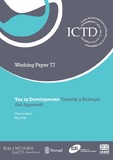| dc.description.abstract | Raising a higher share of the value added in an economy for the public purpose is associated with state building, modern economic growth and development. From 2002-3 to date, low- and lower-middle income countries raised total tax and non-tax revenue from 11-12 per cent and 18-19 per cent of GDP up to 17-18 per cent and 25-26 per cent of GDP in 2014-15. Continuing to improve tax systems is key to realising the development dividend available today through improved technology and institutions, whereby it is possible to raise living standards faster and at lower cost. The remaining development challenges are significant for the majority of the world’s population and therefore the Sustainable Development Goals (SDGs) were agreed in 2015 to address these challenges. The majority of the financing for the SDGs must come from domestic sources (as it did with the Millennium Development Goals, with a 77 per cent share). This being the case, it is surprising that in 2015 only 0.13 per cent of global official development assistance was utilised to promote improved tax and revenue systems. With the Addis Ababa Agenda and the Addis Tax Initiative, this is changing, and several donors and partners are in the process of scaling up support to domestic resource mobilisation and tax system reforms. Therefore, it is of relevance to share some thoughts on the underlying objectives and justification for raising domestic revenues, experiences with revenue and tax-related aid, and a first-level layer framework for assessment of potential partner countries (low- and lower-middle). A ranking exercise is presented, utilising some key economic indicators such as income, poverty, financing levels of expenditure and investment (domestic and foreign), tax effort, tax aid, and a political and institutional assessment. This paper finds a significant group of developing countries that receive limited assistance and have both large needs and large potential in terms of tax and revenue. The top ten countries are in sub-Saharan Africa. Links are provided to the Norwegian partner country categorisation to illustrate the correlation between these two types of country ranking/prioritisation. Finally, other factors relating to donor-partner analysis and dialogue are discussed, including political and administrative prioritisation of revenue reforms, absorptive capacity in institutions, and the likelihood of particular interventions delivering results. | en |


